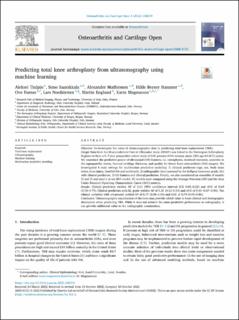| dc.contributor.author | Tiulpin, Aleksei | |
| dc.contributor.author | Saarakkala, Simo | |
| dc.contributor.author | Mathiessen, Alexander | |
| dc.contributor.author | Hammer, Hilde Berner | |
| dc.contributor.author | Furnes, Ove Nord | |
| dc.contributor.author | Nordsletten, Lars | |
| dc.contributor.author | Englund, Martin | |
| dc.contributor.author | Magnusson, Karin | |
| dc.date.accessioned | 2023-01-30T13:03:46Z | |
| dc.date.available | 2023-01-30T13:03:46Z | |
| dc.date.created | 2022-12-20T12:22:59Z | |
| dc.date.issued | 2022 | |
| dc.identifier.issn | 2665-9131 | |
| dc.identifier.uri | https://hdl.handle.net/11250/3047135 | |
| dc.description.abstract | Objective
To investigate the value of ultrasonographic data in predicting total knee replacement (TKR).
Design
Data from the Musculoskeletal Pain in Ullensaker study (MUST) was linked to the Norwegian Arthroplasty Register to form a 5–7 year prospective cohort study of 630 persons (69% women, mean (SD) age 64 (8.7) years). We examined the predictive power of ultrasound (US) features, i.e. osteophytes, meniscal extrusion, synovitis in the suprapatellar recess, femoral cartilage thickness, and quality for future knee osteoarthritis (OA) surgery. We investigated 4 main settings for multivariate predictive modeling: 1) clinical predictors (age, sex, body mass index, knee injury, familial OA and workload), 2) radiographic data (assessed by the Kellgren Lawrence grade, KL) with clinical predictors, 3) US features and clinical predictors. Finally, we also considered an ensemble of models 2) and 3) and used it as our fifth model. All models were compared using the Average Precision (AP) and the Area Under Receiver Operating Characteristic Curve (AUC) metrics.
Results
Clinical predictors yielded AP of 0.11 (95% confidence interval [CI] 0.05–0.23) and AUC of 0.69 (0.58–0.79). Clinical predictors with KL grade yielded AP of 0.20 (0.12–0.33) and AUC of 0.81 (0.67–0.90). The clinical variables with ultrasound yielded AP of 0.17 (0.08–0.30) and AUC of 0.79 (0.69–0.86).
Conclusion
Ultrasonographic examination of the knee may provide added value to basic clinical and demographic descriptors when predicting TKR. While it does not achieve the same predictive performance as radiography, it can provide additional value to the radiographic examination. | en_US |
| dc.language.iso | eng | en_US |
| dc.publisher | Elsevier | en_US |
| dc.rights | Navngivelse 4.0 Internasjonal | * |
| dc.rights.uri | http://creativecommons.org/licenses/by/4.0/deed.no | * |
| dc.title | Predicting total knee arthroplasty from ultrasonography using machine learning | en_US |
| dc.type | Journal article | en_US |
| dc.description.version | publishedVersion | en_US |
| dc.rights.holder | Copyright 2022 The Author(s) | en_US |
| dc.source.articlenumber | 100319 | en_US |
| cristin.ispublished | true | |
| cristin.fulltext | original | |
| dc.identifier.doi | 10.1016/j.ocarto.2022.100319 | |
| dc.identifier.cristin | 2095656 | |
| dc.source.journal | Osteoarthritis and Cartilage Open | en_US |
| dc.identifier.citation | Osteoarthritis and Cartilage Open. 2022, 4 (4), 100319. | en_US |
| dc.source.volume | 4 | en_US |
| dc.source.issue | 4 | en_US |

